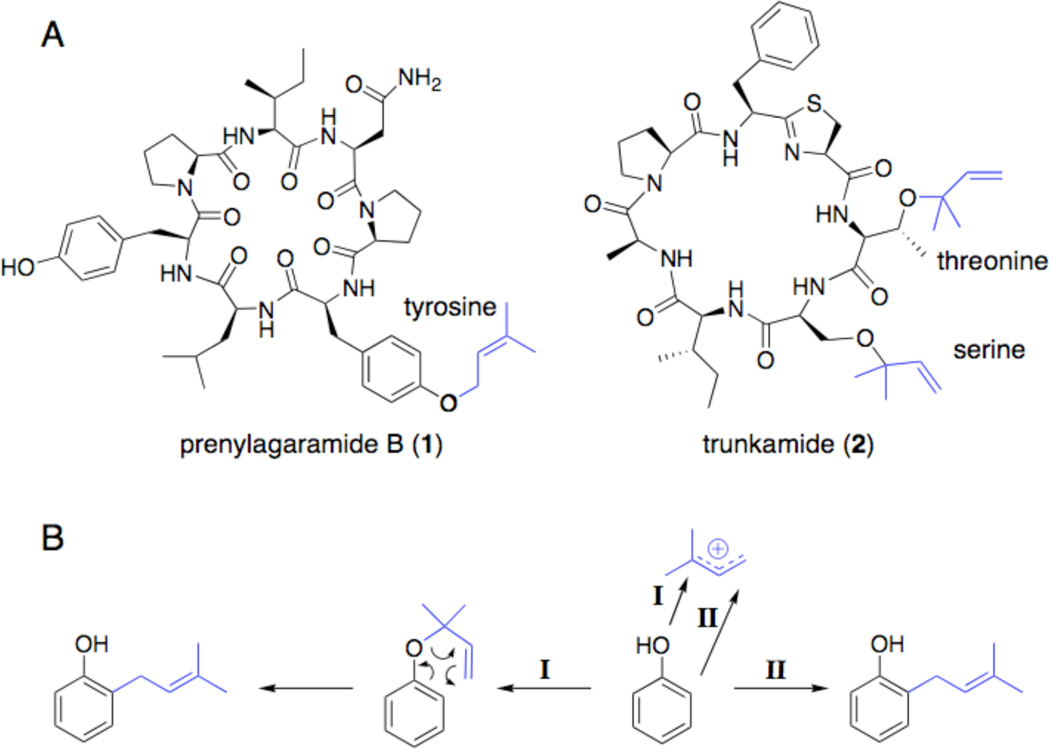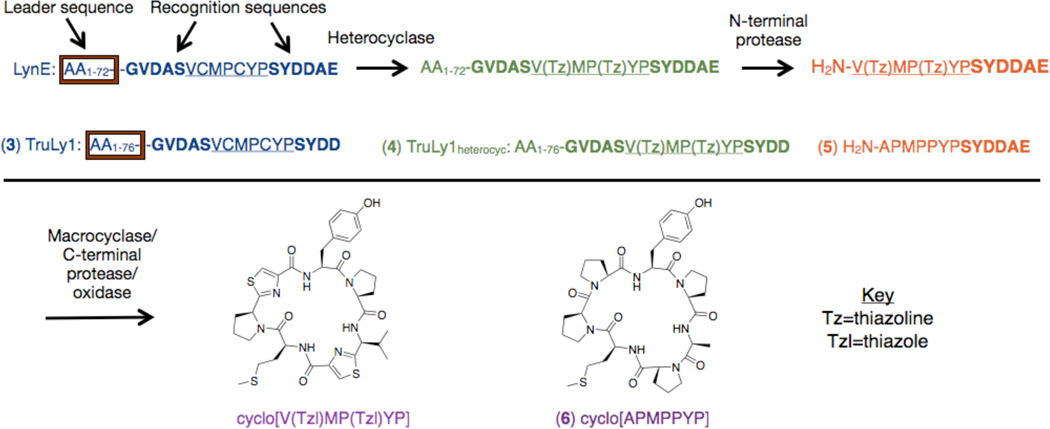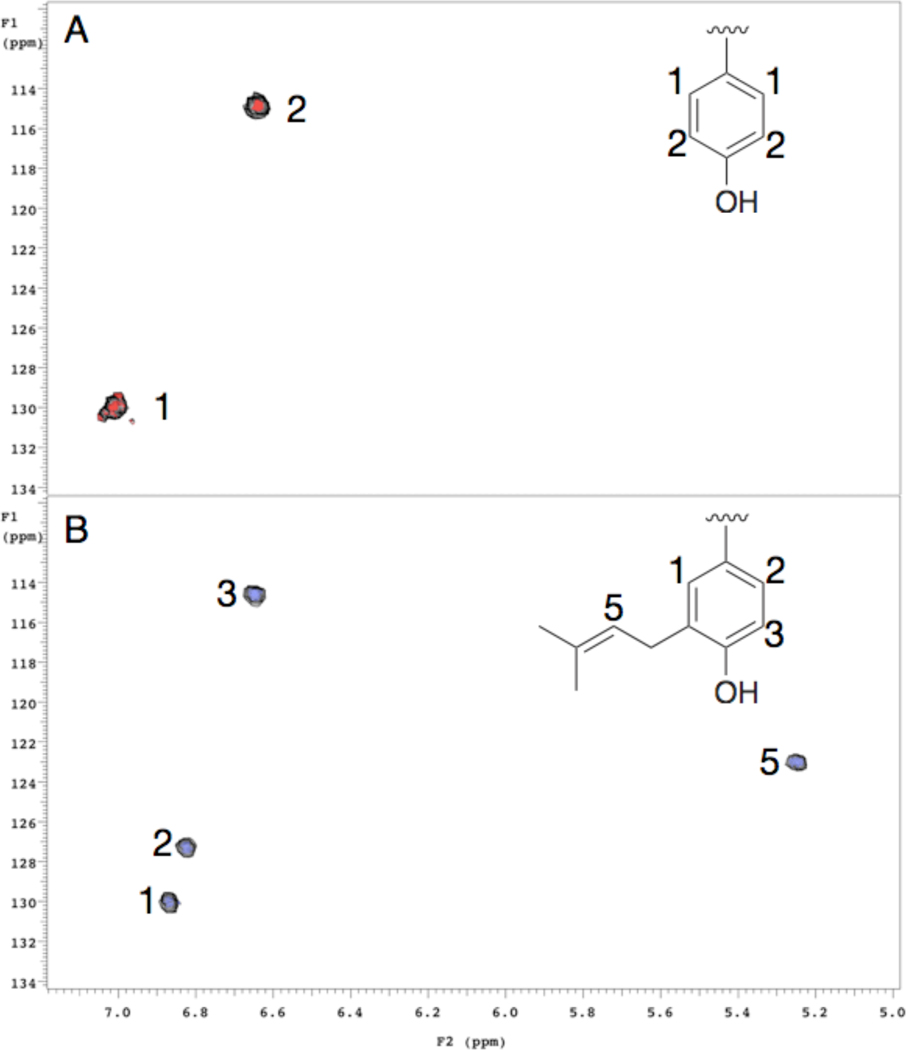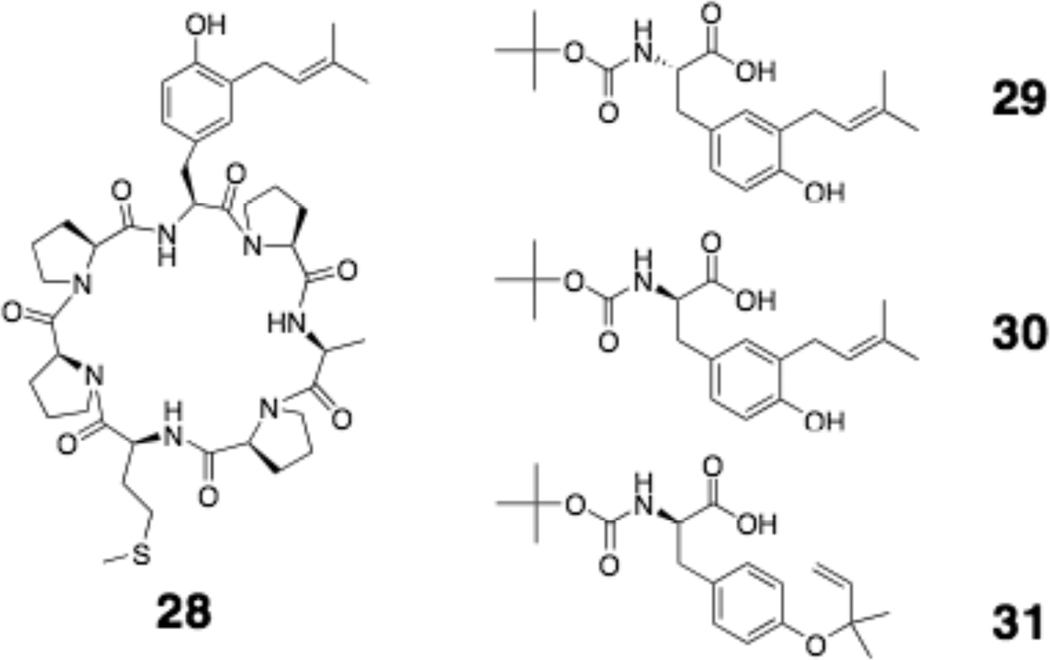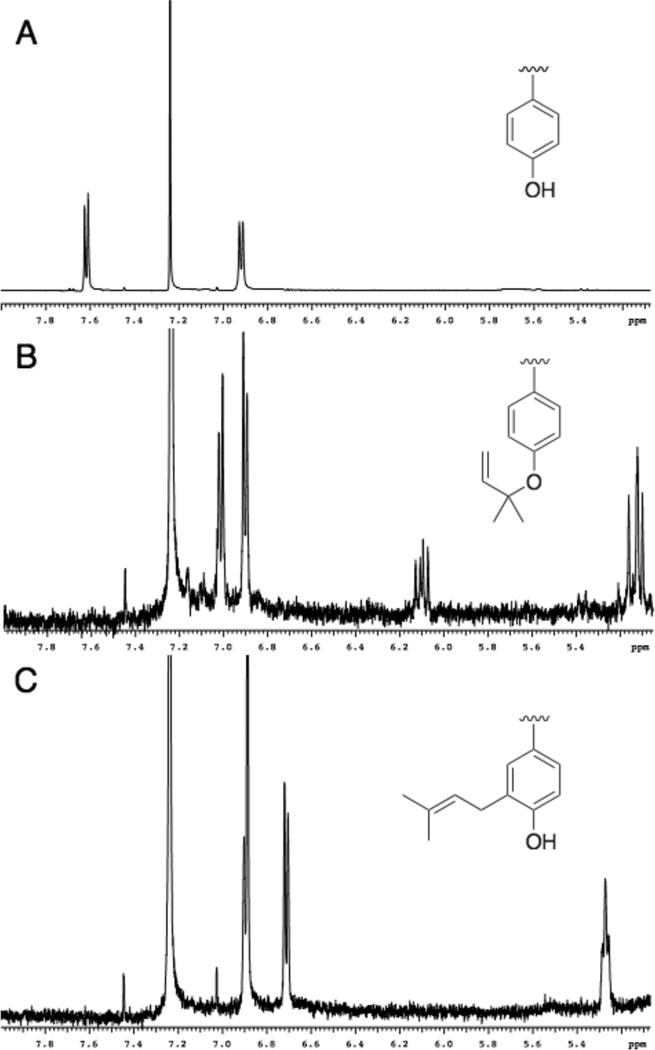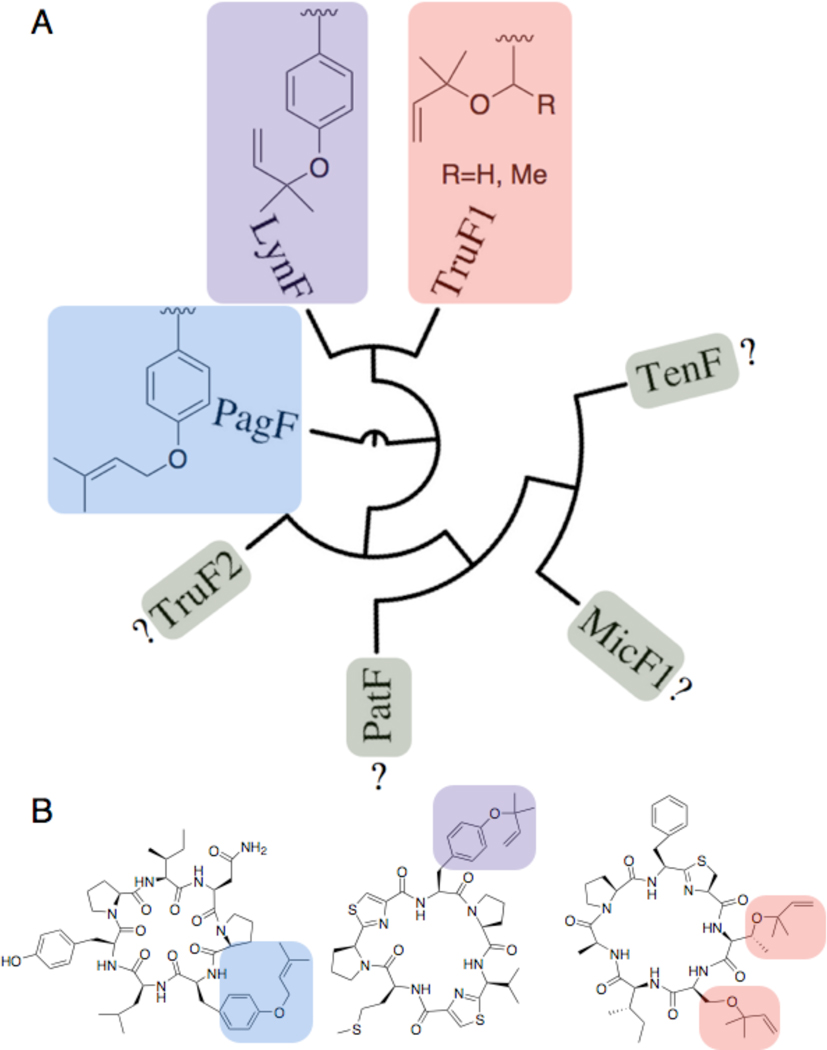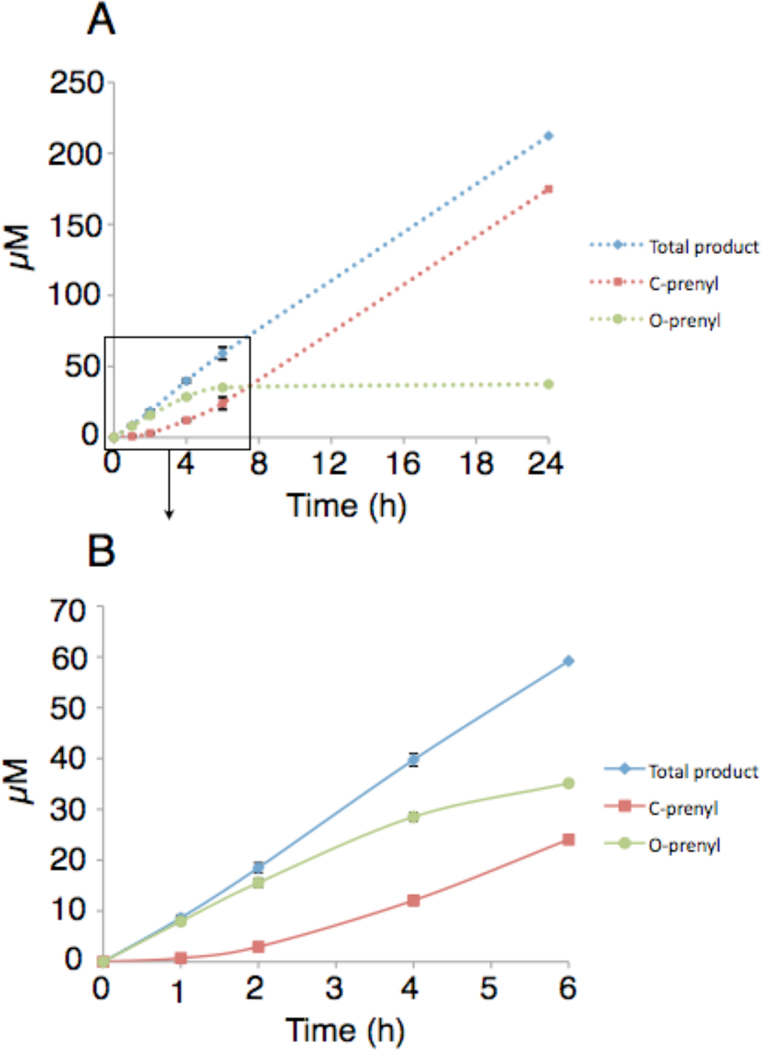Abstract
The enzymatic basis of ribosomal peptide natural product prenylation has not been reported. Here, we characterize a prenyltransferase, LynF, from the TruF enzyme family. LynF is the first characterized representative of the TruF protein family, which is responsible for both reverse- and forward-O-prenylation of tyrosine, serine, and threonine in cyclic peptides known as cyanobactins. We show that LynF reverse O-prenylates tyrosine in macrocyclic peptides. Based upon these results, we propose that the TruF family prenylates mature cyclic peptides, from which the leader sequence and other enzyme recognition elements have been excised. This differs from the common model of ribosomal peptide biosynthesis, in which a leader sequence is required to direct posttranslational modifications. In addition, we find that reverse O-prenylated tyrosine derivatives undergo a facile Claisen rearrangement at ‘physiological’ temperature in aqueous buffers, leading to forward C-prenylated products. Although the Claisen rearrangement route to natural products has been chemically anticipated for at least 40 years, it has not been demonstrated as a route to prenylated natural products. Here, we show that the Claisen rearrangement drives phenolic C-prenylation in at least one case, suggesting that this route should be reconsidered as a mechanism for the biosynthesis of prenylated phenolic compounds.
Keywords: prenyltransferase, prenylation, ribosomal peptide, cyanobactin, trunkamide, cyanobacteria, natural products, Claisen rearrangement
Introduction
Prenylation is a common biochemical modification that has been studied in detail in numerous systems.1,2 For example, proteins are often farnesylated or geranylgeranylated on cysteine residues, and numerous peptide natural products are known to be prenylated at diverse positions. Prenylation is key to the biological activity of these molecules.3,4 Several enzyme families have been described that catalyze prenyl transfer, and indeed whole new prenyltransferase (PT) families continue to be discovered.5–9 For example, the ABBA family has been shown to catalyze aromatic C-prenylation on a variety of substrates,10 especially ortho to phenolic oxygen. Several ribosomal peptide natural products, such as ComX and the cyanobactins, are prenylated in unique ways that greatly increase the chemical diversity of the resulting compounds.11–13 PTs for this growing ribosomal peptide natural product group have yet to be enzymatically characterized.14
Cyanobactins are a broadly distributed group of ribosomally-derived, macrocyclic peptides whose biosynthetic genes are homologous. These compounds are often highly post-translationally modified. Indeed, many cyanobactins are prenylated by dimethylallyl pyrophosphate (DMAPP) on the oxygen atom of serine, threonine, or tyrosine, (Figure 1) all of which are biochemically unprecedented reactions in the context of ribosomal peptides. Among cyanobactins, prenylation is known to occur in the “reverse” position (DMAPP 3-carbon) with serine and threonine, and in the “forward” position (DMAPP 1-carbon) with tyrosine. However, no obvious candidate PTs exist in cyanobactin gene clusters.11 By comparing several cyanobactin pathways discovered by metagenome sequencing, we proposed that the TruF family of proteins might be PTs.11 Given that the TruF family lacks the typical sequence hallmarks of PTs, we sought to obtain biochemical evidence for this proposal. Consequently, we explored the set of sequenced gene clusters to find a soluble TruF relative for biochemical analysis.15 Among TruF relatives, one protein, LynF from Lyngbya aestuarii,16,17 could be solubly expressed in Escherichia coli. Although the other steps in cyanobactin biosynthesis have been characterized,18–21 the PT substrate was unknown prior to this study. Consequently, substrate analogues for each possible biochemical step were synthesized, and their products upon reaction with LynF were analyzed (Figure 2). We show here that the LynF/TruF family represents a remarkably broad-substrate family of O-prenyltransferases, with LynF prenylating a wide variety of tyrosyl peptides and phenol derivatives. Among biosynthetically relevant substrates, only cyclic peptides are prenylated.
Figure 1. Prenylation in natural products.
(A) Representative cyanobactin peptide natural products, showing groups derived from DMAPP in blue. (B) Two possible enzymatic mechanisms of phenol ortho-C-prenylation. First, DMAPP is dephosphorylated to yield a cation that can react either at oxygen (pathway I) or at carbon (pathyway II). In principle, a Claisen rearrangement from pathway I could then yield the C-prenylated product. Only pathway II has been previously linked to enzymatic modification.
Figure 2. Defining the biosynthetic route to prenylated cyanobactins.
Proposed biosynthetic scheme for lyn pathway showing modification of precursor peptide by heterocyclization, proteolysis, macrocyclization and prenylation. The first steps in this route are supported by previous enzymological studies, but the timing of prenylation was not known. Enzyme recognition elements are highlighted. Analogues (3–6) were used to assess prenylation of each possible biosynthetic intermediate and are shown in analogous colors beneath each proposed biosynthetic intermediate. Pro was substituted as an approximate isostere for thiazole in later analogues. No reaction was observed with any intermediate except the final cyclic peptide, showing that prenylation occurs at a late step, after all enzyme recognition elements have been excised.
Unexpectedly, reactions catalyzed by LynF led to carbonprenylated phenolic products. Generally speaking, PTs catalyze electrophilic alkylation of their substrates. In the case of aromatic substrates, reactions are thought to proceed via electrophilic aromatic substitution.10 However, several alternative mechanisms exist. For one, it has been proposed since at least the early 1970s that C-prenylated phenols might also arise via reverse O-prenylation of phenols followed by a Claisen rearrangement (Figure 1).22 This chemical proposal was exploited in several elegant ‘biomimetic’ total syntheses of complex natural products.23,24 Despite a resurgence of biochemical studies of aromatic PTs in recent years,6,8,10,25–30 the Claisen rearrangement proposal has not been revisited. Here, in addition to characterizing a novel PT family, we show that enzymatically synthesized aromatic C-prenylated phenols can indeed arise via the Claisen rearrangement pathway.
Results
Expression of LynF and synthesis of substrates
We found that several of the TruF-group PTs were difficult to overexpress. Fortuitously, in our search for candidate PTs, LynF (44% amino acid identity with TruF1), from the lyn pathway of the cyanobacterium L. aestuarii, was readily expressed in E. coli in soluble form. We predicted that LynF should prenylate phenols, but there are no known natural products of the lyn pathway.16,17 Therefore, analogues of possible substrates were synthesized, including linear peptides representing putative pathway intermediates as well as cyclo[ APMPPYP] (6), which is similar to the predicted lyn pathway product (Figure 2, Table 1). Additionally, reactions with several wholly unnatural phenol derivatives and linear peptides containing tyrosine were attempted. The purity and identity of the synthetic substrates were assessed spectroscopically.
Table 1.
Substrates assayed.
| # | Substrate | Yield |
|---|---|---|
| 3 | TruLy1 precursor peptide | NR |
| 4 | TruLy1 w/ 3 heterocycles | NR |
| 5 | APMPPYPSYDDAE | NR |
| 6 | cyclo[APMPPYP] | 48% |
| 7 | APMPPYP | 12% |
| 8 | N-acetyl APMPPYP | 10% |
| 9 | cyclo[APMPPPAPMPPYP] | 47% |
| 10 | cyclo[APMPPYPAPMPPYP] | 43% |
| 11 | cyclo[KKPYILP] | 37% |
| 12 | cyclo[KPYILP] | 94% |
| 13 | KPYILP | 1% |
| 14 | Boc-L-Tyr | 71% |
| 15 | Boc-D-Tyr | 66% |
| 16 | Boc-4-cyano-L-Phe | NR |
| 17 | Boc-O-allyl-L-Tyr | NR |
| 18 | Boc-4-iodo-L-Phe | NR |
| 19 | Boc-4-methoxy-L-Phe | NR |
| 20 | L-Phe | NR |
| 21 | N-acetyl-L-Tyr | 3% |
| 22 | L-Tyr | NR |
| 23 | Dopamine | NR |
| 24 | Phenol | NR |
| 25 | L-Trp | NR |
| 26 | cyclo[QGGRGDWP] | NR |
| 27 | QGGRGDWPAYDGE | NR |
All yield quantitations are based on HPLC (for 6–8, 14–25) or MS (3–5, 9–13) analyses of 24 h reactions and do not represent isolated yields. NR (no reaction) denotes no detectable prenylation of tyrosine or derivatives. All substrates were run at 100 µM except 3, 4, 9, 10, 11, and 12 (14, 14, 70, 30, 20, and 20 µM respectively). Both full (100 µM) and reduced concentrations (28, 56 µM) were employed with substrates 6 and 14 in order to compare data for substrates tested at reduced concentration.
LynF is a tyrosine PT
When incubated with DMAPP and MgCl2, LynF catalyzed the prenylation of peptides and a subset of phenols related to tyrosine (Table 1). Mg2+ was added because many PTs require it for function.10 Indeed, LynF does not function in the absence of either Mg2+ or Mn2+. Tyrosine prenylation was demonstrated by Fourier-transform ion cyclotron resonance (FT-ICR) and MS/MS fragmentation, which revealed the presence of the expected ions (Table S2) and also localized the prenylation to tyrosine (Figure S1).
LynF prenylated several tyrosine-containing substrates and showed a strong preference for reaction with cyclic over linear peptides (Table 1). In contrast to typical ribosomal peptide biosynthesis,31 LynF did not act on pathway intermediates (3–5) that still contained a leader sequence or enzyme “recognition elements” (Figures 2, S1–S2). Of biosynthetically relevant substrates, LynF acted only on the mature cyclic peptides, such as 6. Overall, LynF was capable of prenylating a broad variety of cyclic peptides, including substrates (9–12) containing 6-, 7-, 13-, and 14-amino acid residues. Surprisingly, LynF also prenylated several tyrosine-containing substrates that are not relevant to the natural biosynthetic pathway. Tyrosine itself was not a substrate, but boc-L-tyrosine and other N-terminally blocked tyrosine derivatives were readily prenylated (14, 15, 21). Derivatives lacking a free phenolic -OH were not substrates (16–20). Overall, LynF appears to require a blocked N-terminus but otherwise exhibits relaxed substrate specificity.
LynF products are ortho-C-prenylated
Based upon the known products of cyanobactin pathways, we expected that LynF would catalyze forward O-prenylation of phenol.11,32 We performed large-scale enzymatic reactions with long incubation times to generate sufficient quantities of products for NMR analysis. Products of two different LynF substrates, 6 and 14, were isolated by HPLC and characterized by NMR and high-resolution MS. Surprisingly, by comparison to previously described compounds,33 we established that both 6 and 14 were forward C-prenylated, ortho to the phenolic hydroxyl group (Figures 3, S3).
Figure 3. LynF is ortho-C-prenylating.
The aromatic / olefin region of the HSQC NMR spectra are shown for boc-tyrosine (14) (A) and its purified enzymatic product with LynF (B), clearly indicating a single, forward C-prenylation event. Similar spectra were also observed for reactions containing 6. NMR and MS characterization of compounds is presented in Supporting Figures S1, S3, and S5.
C-prenylation is the result of a Claisen rearrangement
Initially, we assumed that LynF catalyzed electrophilic aromatic substitution at the ortho position in a manner identical with that reported for ABBA PTs. With an eye towards constructing a Hammett plot of reactivity, we assayed the LynF catalyzed prenylation of a series of 4-substituted Tyr derivatives (16–20) (Table 1). However, all of these reactions failed. If LynF-catalyzed prenylation were to occur via electrophilic aromatic substitution, then one would expect a broader scope of reactivity, as was found for dimethylallyl tryptophan synthase.34
An alternative mechanism for the formation of ortho C-prenylated phenols involves reverse O-prenylation followed by Claisen rearrangement of the resulting O-allyl intermediate.22 In that vein, careful examination of LC-FT-ICR analyses of reaction mixtures showed that upon reaction with LynF, all substrates gave rise to two products (Figure S1). These products were isobaric and prenylated on tyrosine. However, one product was prenylated on carbon, and the other on oxygen. Forward carbon prenylation had been established using 28 (Scheme 1), which was purified and characterized by NMR as described above. Of the two products of LynF upon reaction with 6, purified 28 was found to be identical to the early eluting product (Figure S4). Moreover, no fragmentation of the C-prenyl moiety on 28 could be observed in MS-MS experiments. Similarly, for all LynF products, we observed that the early-eluting compound was prenylated on tyrosine but did not lose isoprene in MS-MS, indicating C-prenylation.
Scheme 1. NMR characterized products.
In contrast, all late-eluting products evinced prominent loss of isoprene (C5H8) in their MS-MS spectra. Loss of C5H8 from prenylated phenols is diagnostic of O-prenylation, as shown in previous studies.35–37 This reaction was more difficult to characterize by NMR owing to the apparent instability of the O-prenylated products. Fortuitously, we were able to isolate one of these compounds, resulting from reaction of 15 (Figures 4, S5). NMR analysis of the purified material confirmed that the product (31) was O-prenylated and conclusively demonstrated that O-prenylation occurred in the reverse orientation. Purified 31 was then added to aqueous buffer at 37 °C (for buffer composition see Materials and Methods section), and it rapidly and spontaneously rearranged to form the forward C-prenylated product 30 which was identical to the previously NMR-characterized product, 29.
Figure 4. LynF catalyzes reverse O-prenylation of tyrosine.
The aromatic / olefin region of 1H NMR spectra are shown (A) for boc-tyrosine (14) (B) the HPLC-purified intermediate LynF product (31), and (C) the final reaction product (30). These spectra clearly indicate that the first product of the LynF reaction is reverse-O-prenyl tyrosine, which subsequently rearranges to give the C-prenylated product.
Reverse O-prenylated phenols are known to undergo the Claisen rearrangement to yield forward ortho C-prenylated products.22,24,38,39 Thus, we realized that if the sole enzymatic reaction catalyzed by LynF were reverse O-prenyltransfer on Tyr, that this would lead to the mixture of products we had consistently observed with all substrates. Alternatively, we supposed that LynF might carry out reverse O-prenyltransfer in addition to direct electrophilic aromatic substitution in the forward direction on carbon. To distinguish between these two possibilities, a kinetic analysis for reactions containing 14 was performed in which C- and O-prenyl products were followed over 24 hours in reactions performed in quadruplicate (Figure 4). The O-prenyl product appeared first, with a delayed onset of 29. After 4 h of reaction time, a steady state was reached in which the rate of prenylation was equal to the rate of the Claisen rearrangement. Interpretation of the kinetic data, which assumed a unimolecular mechanism and steady-state levels of O-prenyl intermediate, yielded a rate of rearrangement of 8.3 µM/h, and a rate constant for the Claisen rearrangement (k where rate of Claisen = k*[O-prenyl intermediate]) of 0.23 h−1. Taken together with the absence of reactivity observed with analogues lacking a free phenolic -OH, these data show that the initial enzymatic reaction is reverse O-prenylation, followed by slower conversion to a forward C-prenylated phenol
Having shown that the O-prenylated compound is the product of initial prenyltransfer, we sought to determine whether the rearrangement to the forward C-prenylated compound was enzyme catalyzed. To do so, purified O-prenylated 31 was added to enzyme, buffer, or boiled enzyme. Under all three conditions, 31 was efficiently converted into C-prenylated 30 without any appreciable enzymatic acceleration (Figure S6).
This spontaneous Claisen rearrangement might seem surprising given that in the synthetic literature, reverse prenylated phenols require elevated temperatures for rearrangement.24,38 However, these synthetic reactions take place in organic solvents, while we have employed aqueous solvents. Indeed, the speed with which we have observed reverse O-prenylated phenols to rearrange is unsurprising in light of the known aqueous acceleration of the Claisen rearrangement.40–45 Here we show by experiment that the rearrangement goes to completion at 37 °C in aqueous buffers. Consequently, our conditions may provide a particularly mild reaction condition for the Claisen rearrangement for use in future synthetic studies.
To further examine the rapid rearrangement observed with 31, we purchased O-allyl-boc-L-tyrosine and examined it to see if its rearrangement might be accelerated with enzyme or the buffer conditions employed with 31. In contrast to the prenylated substrates, this compound did not undergo the Claisen rearrangement under the aforementioned conditions. Based upon these results, it seems that the geminal methyl groups adjacent to the phenolic oxygen are required to promote the Claisen rearrangement at relatively low temperatures. This effect can be rationalized as an example of the gem substituent effect, which is believed to accelerate the Claisen rearrangement.46 Indeed, it has been shown that the presence of bulky substituents α-to oxygen can accelerate the Claisen rearrangment and similar reactions,47,48 though to the best of our knowledge this is the first direct comparison of these substrates in the aromatic Claisen rearrangement.
Phylogenetic analysis of LynF and homologues nicely rationalizes the observed pattern of reactivity, where LynF is most closely related to TruF1 and PagF (Figure 6). In light of the above biochemical evidence, TruF1 can be assigned the role of a reverse O-prenyltransferase acting on Ser and Thr, while PagF can be assigned the role of a forward O-prenyltransferase acting on Tyr. Thus, that LynF would carry out reverse O-prenylation of Tyr is unsurprising in light of its phylogenetic profile.
Figure 6. Phylogenetic analysis of the TruF / LynF family.
(A) TruF-group proteins cluster according to whether natural products are prenylated (top) or non-prenylated (bottom). Chemical products are shown for each TruF-like protein, where they exist. No TruF-like sequence relatives can be identified outside of cyanobactin gene clusters using either BLAST searching or sequence alignments with other PT family proteins, indicating that this is a novel group of PTs. (B) Actual product structures of prenylagaramide (left) and trunkamide (right) pathways; predicted enzymatic product of lyn pathway (middle) prior to Claisen rearrangement.
Kinetic measurements
LynF catalyzed reaction rates were measured in triplicate using two different substrates: cyclo[ APMPPYP] (6), and an unnatural substrate, boc-L-tyrosine (14) (Figure S7). Using HPLC analysis, the turnover numbers for 6 and 14 were similar (14 h−1 and 63 h−1, respectively), as were Km values (4 and 14 mM, respectively). These rates are slower than those typically reported for prenyltransferases.27,49 However, the apparent slowness of reactions catalyzed by LynF is not unusual when compared with rates observed with other cyanobactin biosynthetic enzymes. Some of these reactions are quite slow, a fact that has been attributed to their extremely broad substrate tolerance, and by extension their relatively low affinities for any given substrate.18–21
Discussion
To the best of our knowledge, LynF represents the first enzymatically characterized PT leading to the synthesis of ribosomal peptide natural products. Further, serine and threonine O-PTs have not been previously described, nor have tyrosine O-PTs acting on ribosomal peptides.14 Although these posttranslational modifications are currently known only in the cyanobactin family of natural products, cyanobactins are present in perhaps ~30% of all cyanobacteria on Earth and therefore constitute a major fraction of bioactive natural products globally.50 Another salient feature of this enzyme group is that it clearly acts on polypeptide products, while most other natural product DMAPP transferases act on starting amino acids or on small dipeptides. For example, forward O-prenylated tyrosine has recently been characterized in sirodesmin dike-topiperazine biosynthesis.49,51 However, in this case tyrosine itself is the substrate for prenylation, and the product does not result from ribosomal synthesis.
Phenols themselves are C- or O-prenylated in many small molecule natural products.10 In all cases that have been characterized so far, it is thought that C-prenylated phenols arise from direct electrophilic aromatic substitution.10 Although the Claisen rearrangement was long-predicted from ‘biomimetic’ chemistry, a biochemical demonstration of its relevance as a route to C-prenylated phenols was lacking. Here, we show that the Claisen rearrangement route can indeed occur to afford C-prenylated products. This route could easily be missed, since the O-prenylated intermediates are short-lived, and not easily detected by commonly used analytical methods. For example, the intermediates have extremely weak absorption at λ = 280 nm, and their fluorescence spectra are different than for unsubstituted or C-prenylated phenols. The rearrangement is relatively rapid and continues even after enzymes have been denatured or inactivated. Given aqueous acceleration of the Claisen rearrangement, and the acceleration provided by the geminal methyl groups of the reverse prenylation, the ease with which the Claisen rearrangement might occur in a cellular context has perhaps been underestimated. Overall, forward prenylation via electrophilic aromatic substitution and reverse O-prenylation followed by the Claisen rearrangement will be indistinguishable under many conditions.
We initially expected that the Claisen rearrangement might be enzymatically accelerated. In synthetic chemistry, several guanidinium-based synthetic catalysts of the Claisen rearrangement have been reported.38,52 Additionally, in the premier example of a biological Claisen rearrangement, chorismate mutase has been calculated to provide rate-enhancements of >106.53 However, it is clear from our results using purified reverse-O-prenylated 31 that in this case the reaction is spontaneous. Given the spontaneous nature of this transformation, and the similarity to other reported Claisen rearrangments, the simplest hypothesis is that 31 proceeds to 30 via the Claisen rearrangment, and not via some other, more complicated mechanism.
We have previously shown that proteins in this group were involved in pathways to very sequence-diverse prenylated natural products in vivo,16 and here we show that purified LynF accepts many different cyclic substrates. This broad specificity is especially remarkable in that LynF substrates share no common sequence features that would provide robust enzyme recognition elements. In ribosomal peptide natural product synthesis, enzymes commonly recognize conserved motifs in a leader peptide, which is subsequently cleaved and discarded, allowing the enzymes to modify diverse sequences.31 However, in this case the reaction proceeds after the leader sequence and recognition elements have already been removed.
The structure and catalytic mechanism of this new family of PTs remain to be determined. Although the proteins bear no homology to any other characterized protein outside of cyanobactin gene clusters, it remains possible that they are structurally related to known PTs. However, no putative ABBA-like required residues are present in the correct places in these proteins (Figure S8). Since PTs are often deeply divergent, and sequence similarity is completely lacking for this protein class, a final comparison will await structural study. It is also unknown why non-prenylating cyanobactin clusters usually contain (and even require) LynF-like proteins.16,50 In these non-prenylating cases, all enzymatic roles have been assigned, so that LynF homologues serve no obvious enzymatic function.20,21 However, removal of the lynF-homologue from heterologous expression of the non-prenylating pat pathway in E. coli abolishes compound production.16 Possible roles include a chaperone function, or perhaps interaction with the leader sequence.
In conclusion, we show that the TruF/LynF group of proteins represents a new family of PTs that catalyze unprecedented enzymatic reactions and that are quite distinct from previously characterized proteins. LynF represents the first ribosomal peptide natural product prenyltransferase to be characterized, opening the door to the study of prenylated ribosomal peptide natural products.
Materials and Methods
For detailed methods, see Supporting Materials and Methods.
Substrates
Dimethylallyl pyrophosphate (DMAPP) was synthesized following previously established procedures.54–56 Excepting 11, 12 and 26 whose synthesis and characterization has been reported elsewhere,15,19 peptide substrates were synthesized at the University of Utah DNA/peptide synthesis core facility. Synthesis of boc-protected 4-iodo-L-phenylalanine and 4-methoxy-L-phenylalanine was performed according to previously established procedures.57 Boc-L-tyrosine, sodium hydrogen pyrophosphate, dimethylallyl bromide, tetrabutylammonium hydroxide, and dopamine HCl were purchased from Sigma. N-acetyl-L-tyrosine and phenol were purchased from Fisher Scientific. All other Tyr and Phe derivatives were purchased from ChemImpex.
Genes and Cloning
A codon-optimized version of lynF was synthesized and cloned into pET28 in frame with the N-terminal his-tag sequence using NdeI and EcoRI (Genscript). TruLy1 was cloned via modification of a previously described vector,15 which was subsequently cloned into pET28b using NdeI and BamHI.
Protein Expression and Purification
lynF was expressed in BL21(DE3) cells, purified initially by Ni-NTA chromatography, which was followed by size-exclusion chromatography to yield homogenous protein. Purification of TruLy1 was likewise performed by Ni-NTA chromatography, with the main difference being that rather than attempting to isolate soluble protein, truLy1 was strongly overexpressed with the intent of driving the protein into inclusion bodies, after which time purification under denaturing conditions was performed.
Enzyme Assays
Enzyme reactions typically contained enzyme (3.8 µM) and variable substrate concentration (100 µM for most substrates; higher concentrations, i.e. 1 mM, were occasionally employed with boc-protected amino acid derivatives. Exceptions include substrates 11 and 12, which were used at 20 µM final concentration as well as substrates 9, and 10, which were used at 70 and 30 µM, respectively). Several additives (1 M NaCl, 40 mM glycylglycine pH 9.0, 12 mM MgCl2, 3 mM tris(2-carboxyethyl) phosphine (TCEP), and 1 mM DMAPP) were added to all reactions. Reactions were incubated at 37 °C for 24 h in a DNA Engine Peltier thermocycler (Bio-Rad). Enzyme reactions with full-length precursor peptide contained TruLy1 (28 µM), ATP (0.8 mM), with or without heterocyclase enzyme TruD (90 nM), and additives as above. Controls were run to ensure that LynF was active in the presence of TruD and TruLy1, and vice versa. Products were characterized by MS or diode array (λ = 220 and 280 nm) and fluorescence (λ = 271 nm excitation, 303 nm emission) HPLC. Reactions assessing the rate of rearrangement of purified 31 were performed at 37 °C with time points taken at 0 and 8 h, and included the standard additives described above. For descriptions of specific assays, see Supporting Materials.
Phylogenetic Tree Construction
The amino acid sequences of LynF homologues from the functionally characterized cyanobactin pathways were aligned using CLUSTALX. Maximum likelihood analysis with molecular clock PROMLK (PHYLIP) using the bootstrap test method (1000 replicates) was performed to assess the phylogenetic relationship between the different homologues. The same tree branches were also supported using other phylogenetic experiments such as Maximum Parsimony (MEGA 4.0) using 1000 bootstrap replicates.
General Methods
ESI-MS, and FT-ICR analyses were performed at the University of Utah Mass Spectrometry and Proteomics core facility. MALDI-MS analyses were performed on a Micromass MALDI micro MX instrument (Waters). HPLC separations were performed on a LaChrom Elite system (Hitachi). NMR spectra were collected either on 400 or 500 MHz spectrometers (Varian). CD spectra were collected on a Jasco J-815 spectrometer, and data were plotted in Excel.
Supplementary Material
Figure 5. Time course of boc-L-Tyr (14) reaction followed by HPLC.
The reaction was performed in quadruplicate, with variation indicated by error bars (A), (B). Initial product of the reaction is almost exclusively O-prenylated as shown at 1 h, 2 h, and 4 h time points (B). After 4 h, the level of O-prenylated intermediate reaches steady-state and its levels are constant through 24 h, accompanied by steady increase in the concentration of C-prenylated final product 29. This allowed kinetic constants for the Claisen rearrangement to be directly determined, since at steady state the concentration of the O-prenyl intermediate can be assumed to be a constant.
Scheme 2. Claisen rearrangement pathway.
ACKNOWLEDGMENT
Funding Sources
This work was supported by NIH GM071425.
We thank C. Dale Poulter, Jeffrey Rudolph, Gary E. Keck, and John Heemstra for helpful discussions; Chad Nelson, Krishna Parsawar, and Jim Muller for mass spectrometry assistance; Scott Endicott and Robert Schackmann for peptide synthesis; Seth Lilavivat for circular dichroism assistance; Jack Skalicky, Jay Olsen, Dai Tianero, and Zhenjian Lin for NMR assistance. We dedicate this manuscript to the late Prof. D. John Faulkner for his pioneering work on the Claisen rearrangement and marine natural products.
ABBREVIATIONS
- PT
prenyltransferase
- DMAPP
dimethylallyl pyrophosphate
- LC
liquid chromatography
- FT-ICR
Fourier transform ion cyclotron resonance
- MS
mass spectrometry
- NMR
nuclear magnetic resonance
- COSY
correlation spectroscopy
- HSQC
heteronuclear quantum coherence
Footnotes
SUPPORTING INFORMATION AVAILABLE.
Additional mass spectrometry, NMR, kinetic, protein purification, sequence, and substrate data. Full methods are also included. This material is available free of charge via the internet. (http://pubs.acs.org/page/jacsat/submission/authors.html).
Author Contributions
The manuscript was written through contributions of all authors. / All authors have given approval to the final version of the manuscript.
REFERENCES
- 1.Brandt W, Bräuer L, Günnewich N, Kufka J, Rausch F, Schulze D, Schulze E, Weber R, Zakharova S, Wessjohann L. Phytochemistry. 2009;70:1758–1775. doi: 10.1016/j.phytochem.2009.09.001. [DOI] [PubMed] [Google Scholar]
- 2.Nguyen UT, Goody RS, Alexandrov K. ChemBioChem. 2010;11:1194–1201. doi: 10.1002/cbic.200900727. [DOI] [PubMed] [Google Scholar]
- 3.Gibbs RA. Nat. Chem. Biol. 2005;1:7–8. doi: 10.1038/nchembio0605-7. [DOI] [PubMed] [Google Scholar]
- 4.Casey PJ, Seabra MC. J. Biol. Chem. 1996;271:5289–5292. doi: 10.1074/jbc.271.10.5289. [DOI] [PubMed] [Google Scholar]
- 5.Sacchettini JC, Poulter CD. Science. 1997;277:1788–1789. doi: 10.1126/science.277.5333.1788. [DOI] [PubMed] [Google Scholar]
- 6.Edwards DJ, Gerwick WH. J. Am. Chem. Soc. 2004;126:11432–11433. doi: 10.1021/ja047876g. [DOI] [PubMed] [Google Scholar]
- 7.Reiss Y, Goldstein JL, Seabra MC, Casey PJ, Brown MS. Cell. 1990;62:81–88. doi: 10.1016/0092-8674(90)90242-7. [DOI] [PubMed] [Google Scholar]
- 8.Kuzuyama T, Noel JP, Richard SB. Nature. 2005;435:983–987. doi: 10.1038/nature03668. [DOI] [PMC free article] [PubMed] [Google Scholar]
- 9.Gebler JC, Poulter CD. Arch. Biochem. Biophys. 1992;296:308–313. doi: 10.1016/0003-9861(92)90577-j. [DOI] [PubMed] [Google Scholar]
- 10.Saleh O, Haagen Y, Seeger K, Heide L. Phytochemistry. 2009;70:1728–1738. doi: 10.1016/j.phytochem.2009.05.009. [DOI] [PubMed] [Google Scholar]
- 11.Donia MS, Ravel J, Schmidt EW. Nat. Chem. Biol. 2008;4:341–343. doi: 10.1038/nchembio.84. [DOI] [PMC free article] [PubMed] [Google Scholar]
- 12.Carroll AR, Coll JC, Bourne DJ, MacLeod JK, Zabriskie T, Ireland CM, Bowden BF. Aust. J. Chem. 1996;49:659–667. [Google Scholar]
- 13.Okada M, Sato I, Cho SJ, Iwata H, Nishio T, Dubnau D, Sakagami Y. Nat. Chem. Biol. 2005;1:23–24. doi: 10.1038/nchembio709. [DOI] [PubMed] [Google Scholar]
- 14.McIntosh JA, Donia MS, Schmidt EW. Nat. Prod. Rep. 2009;26:537–559. doi: 10.1039/b714132g. [DOI] [PMC free article] [PubMed] [Google Scholar]
- 15.Donia MS, Schmidt EW. Chem. Biol. 2011;18:508–519. doi: 10.1016/j.chembiol.2011.01.019. [DOI] [PMC free article] [PubMed] [Google Scholar]
- 16.Donia MS, Hathaway BJ, Sudek S, Haygood MG, Rosovitz MJ, Ravel J, Schmidt EW. Nat. Chem. Biol. 2006;2:729–735. doi: 10.1038/nchembio829. [DOI] [PubMed] [Google Scholar]
- 17.Leikowski N, Fewer DP, Sivonen K. Appl. Environ. Microbiol. 2009;75:853–857. doi: 10.1128/AEM.02134-08. [DOI] [PMC free article] [PubMed] [Google Scholar]
- 18.McIntosh JA, Schmidt EW. ChemBioChem. 2010;11:1413–1421. doi: 10.1002/cbic.201000196. [DOI] [PMC free article] [PubMed] [Google Scholar]
- 19.McIntosh JA, Robertson CR, Vinayak A, Satish NK, Bulaj GW, Schmidt EW. J. Am. Chem. Soc. 2010;132:15499–15501. doi: 10.1021/ja1067806. [DOI] [PMC free article] [PubMed] [Google Scholar]
- 20.McIntosh JA, Donia MS, Schmidt EW. J. Am. Chem. Soc. 2010;132:4089–4091. doi: 10.1021/ja9107116. [DOI] [PMC free article] [PubMed] [Google Scholar]
- 21.Lee J, McIntosh JA, Hathaway BJ, Schmidt EW. J. Am. Chem. Soc. 2009;131:2122–2214. doi: 10.1021/ja8092168. [DOI] [PMC free article] [PubMed] [Google Scholar]
- 22.Quillinan AJ, Scheinmann F. J. Chem. Soc. D. 1971:966–967. [Google Scholar]
- 23.Tisdale EJ, Slobodov I, Theodorakis EA. Org. Biomol. Chem. 2003;1:4418–4422. doi: 10.1039/b311833a. [DOI] [PubMed] [Google Scholar]
- 24.Nicolaou KC, Li J. Angew. Chem. Int. Ed. 2001;40:4264–4268. doi: 10.1002/1521-3773(20011119)40:22<4264::AID-ANIE4264>3.0.CO;2-1. [DOI] [PubMed] [Google Scholar]
- 25.Jost M, Zocher G, Tarcz S, Matuscheck M, Xie X, Li SM, Stehle T. J. Am. Chem. Soc. 2010;132:17849–17858. doi: 10.1021/ja106817c. [DOI] [PubMed] [Google Scholar]
- 26.Haagen Y, Unsöld I, Westrich L, Gust B, Richard SB, Noel JP, Heide L. FEBS Lett. 2007;581:2889–2893. doi: 10.1016/j.febslet.2007.05.031. [DOI] [PMC free article] [PubMed] [Google Scholar]
- 27.Ding Y, de Wet JR, Cavalcoli J, Li S, Greshock TJ, Miller KA, Finefield JM, Sunderhaus JD, McAfoos TJ, Tsukamoto S, Williams RM, Sherman DH. J. Am. Chem. Soc. 2010;132:12733–12740. doi: 10.1021/ja1049302. [DOI] [PMC free article] [PubMed] [Google Scholar]
- 28.Schultz AW, Lewis CA, Luzung MR, Baran PS, Moore BS. J. Nat. Prod. 2010;73:373–377. doi: 10.1021/np9006876. [DOI] [PMC free article] [PubMed] [Google Scholar]
- 29.Balibar CJ, Howard-Jones AR, Walsh CT. Nat. Chem. Biol. 2007;3:584–592. doi: 10.1038/nchembio.2007.20. [DOI] [PubMed] [Google Scholar]
- 30.Pojer F, Wemakor E, Kammerer B, Chen H, Walsh CT, Li SM, Heide L. Proc. Natl. Acad. Sci. U S A. 2003;100:2316–2321. doi: 10.1073/pnas.0337708100. [DOI] [PMC free article] [PubMed] [Google Scholar]
- 31.Oman TJ, van der Donk WA. Nat. Chem. Biol. 2010;6:9–18. doi: 10.1038/nchembio.286. [DOI] [PMC free article] [PubMed] [Google Scholar]
- 32.Murakami M, Itou Y, Ishida K, Shin HJ. J. Nat. Prod. 1999;62:725–755. doi: 10.1021/np980396g. [DOI] [PubMed] [Google Scholar]
- 33.Ahmed F, Ohtsuki T, Aida W, Ishibashi M. J. Nat. Prod. 2008;71:1963–1966. doi: 10.1021/np8004248. [DOI] [PubMed] [Google Scholar]
- 34.Gebler JC, Woodside AB, Poulter CD. J. Am. Chem. Soc. 1992;114:7354–7360. [Google Scholar]
- 35.Donia MS, Schmidt EW. Chem. Biol. 2011;18:508–519. doi: 10.1016/j.chembiol.2011.01.019. [DOI] [PMC free article] [PubMed] [Google Scholar]
- 36.Sobolev VS, Potter TL, Horn BW. Phytochem. Anal. 2006;17:312–322. doi: 10.1002/pca.920. [DOI] [PubMed] [Google Scholar]
- 37.Miranda CL, Stevens JF, Ivanov V, McCall M, Frei B, Deinzer ML, Buhler DR. J. Agric. Food Chem. 2000;48:3876–3884. doi: 10.1021/jf0002995. [DOI] [PubMed] [Google Scholar]
- 38.Uyeda C, Jacobsen EN. J. Am. Chem. Soc. 2008;130:9228–9229. doi: 10.1021/ja803370x. [DOI] [PMC free article] [PubMed] [Google Scholar]
- 39.Hoarau C, Pettus RRT. Synlett. 2003:127–137. doi: 10.1055/s-2003-36234. [DOI] [PMC free article] [PubMed] [Google Scholar]
- 40.Bagnell L, Cablewski T, Strauss CR, Trainor RW. J. Org. Chem. 1996;61:7355–7359. doi: 10.1021/jo961095j. [DOI] [PubMed] [Google Scholar]
- 41.Narayan S, Muldoon J, Finn MG, Fokin VV, Kolb HC, Sharpless KB. Angew. Chem. Int. Ed. 2005;44:3275–3279. doi: 10.1002/anie.200462883. [DOI] [PubMed] [Google Scholar]
- 42.Majumdar KC, Alam S, Chattopadhyay B. Tetrahedron. 2008;64:597–643. [Google Scholar]
- 43.Knowles JR, Copley SD. J. Am. Chem. Soc. 1987;109:5008–5013. [Google Scholar]
- 44.Grieco PA. Aldrichimica Acta. 1991;24:59–66. [Google Scholar]
- 45.White WN, Wolfarth EU. J. Org. Chem. 1970;35:2196–2199. [Google Scholar]
- 46.Jung ME, Piizzi G. Chem. Rev. 2005;105:1735–1766. doi: 10.1021/cr940337h. [DOI] [PubMed] [Google Scholar]
- 47.Harfenist M, Thom E. J. Org. Chem. 1972;37:841–848. [Google Scholar]
- 48.Goering HL, Jacobson RR. J. Am. Chem. Soc. 1958;80:3277–3285. [Google Scholar]
- 49.Zou HX, Xie X, Zheng XD, Li SM. Appl. Microbiol. Biotechnol. 2011;89:1443–1451. doi: 10.1007/s00253-010-2956-x. [DOI] [PubMed] [Google Scholar]
- 50.Donia MS, Schmidt EW. Comprehensive Natural Products Chemistry II. 2008;Vol. 2:539–558. [Google Scholar]
- 51.Kremer A, Li SM. Microbiology. 2010;156:278–286. doi: 10.1099/mic.0.033886-0. [DOI] [PubMed] [Google Scholar]
- 52.Uyeda C, Rötheli AR, Jacobsen EN. Angew. Chem. Int. Ed. 2010;49:9753–9756. doi: 10.1002/anie.201005183. [DOI] [PMC free article] [PubMed] [Google Scholar]
- 53.Andrews PR, Smith GD, Young IG. Biochemistry. 1973;12:3492–3498. doi: 10.1021/bi00742a022. [DOI] [PubMed] [Google Scholar]
- 54.Woodside AB, Huang Z, Poulter CD. Org. Synth. 1988;66:211–215. [Google Scholar]
- 55.Woodside AB, Huang Z, Poulter CD. Org. Synth. 1993;Coll. Vol. 8:616–620. [Google Scholar]
- 56.Davisson VJ, Woodside AB, Neal TR, Stremler KE, Muehlbacher M, Poulter CD. J. Org. Chem. 1986;51:4768–4779. [Google Scholar]
- 57.Stankova IG, Videnov GI, Golovinsky EV, Jung G. J. Peptide Sci. 1999;5:392–398. doi: 10.1002/(SICI)1099-1387(199909)5:9<392::AID-PSC209>3.0.CO;2-8. [DOI] [PubMed] [Google Scholar]
Associated Data
This section collects any data citations, data availability statements, or supplementary materials included in this article.



